To optimize your solar water heater, focus on key design strategies. Start by orienting collectors southward (in the Northern Hemisphere) and tilting them to match your latitude. Insulate tanks and pipes thoroughly to minimize heat loss. Choose high thermal conductivity materials like copper for efficient heat transfer. Size your tank to meet household needs without excess capacity. Design your circulation system carefully, considering pump and pipe sizing. Integrate smart controls for remote monitoring and performance optimization. Don't forget about backup heating options for consistent hot water. By implementing these strategies, you'll greatly boost your system's efficiency and reliability. Dive deeper to uncover more ways to maximize your solar water heater's performance.
Collector Orientation and Angle
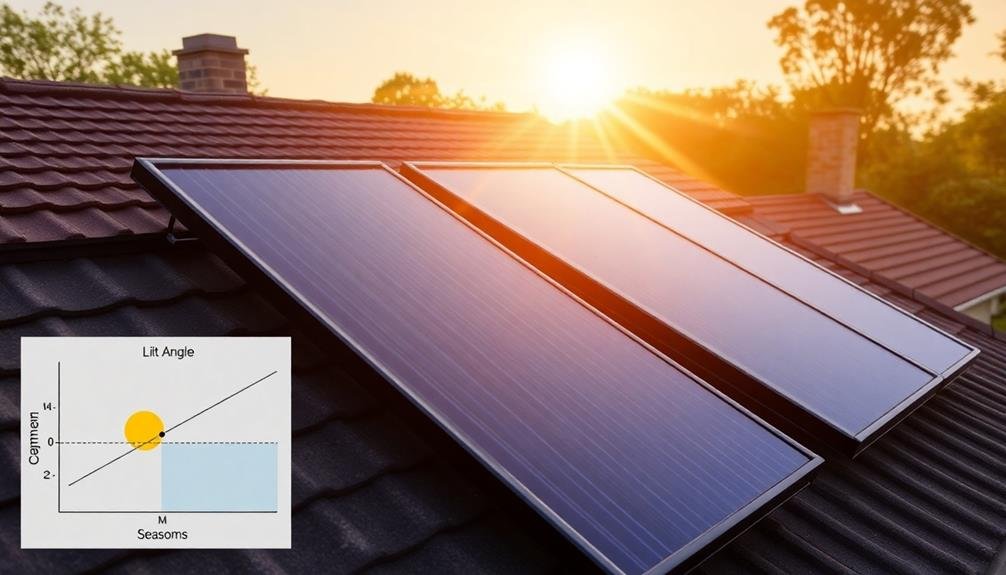
The sun's path across the sky dictates the ideal positioning of your solar water heater's collector. To maximize energy absorption, you'll want to orient your collector to face true south in the Northern Hemisphere or true north in the Southern Hemisphere. This alignment guarantees peak exposure to sunlight throughout the day.
The collector's tilt angle is equally vital. You should set it to match your latitude for year-round use. However, if you're prioritizing winter performance, add 10-15 degrees to your latitude angle. For summer enhancement, subtract 10-15 degrees. This adjustment compensates for seasonal changes in the sun's position.
Consider potential obstructions like trees or buildings that might cast shadows on your collector. You may need to adjust the orientation or elevation slightly to avoid these obstacles. Remember, even a small amount of shading can greatly reduce efficiency.
For flat-roof installations, you'll need to construct a tilted mount. On sloped roofs, try to match the roof's pitch if it's within 15 degrees of your ideal angle. This approach balances performance with aesthetic considerations and simplifies installation.
Insulation Techniques for Heat Retention
While optimizing collector positioning is key, proper insulation plays an equally important role in solar water heater efficiency. You'll want to focus on insulating both the storage tank and the pipes to minimize heat loss.
For the tank, use a high-quality insulation material with an R-value of at least 24. Fiberglass, polyurethane foam, or aerogel are excellent choices. Wrap the tank completely, ensuring there are no gaps or exposed areas.
For the pipes, use foam pipe insulation with a thickness of at least 1 inch. Pay special attention to areas where pipes enter or exit the building, as these are prone to heat loss. Don't forget to insulate valves and fittings as well.
In colder climates, consider using heat tape on exposed pipes to prevent freezing.
Insulate the collector box itself with rigid foam board or reflective insulation to reduce heat loss from the back and sides. Seal any gaps or joints with weatherstripping or silicone caulk.
Efficient Heat Transfer Materials
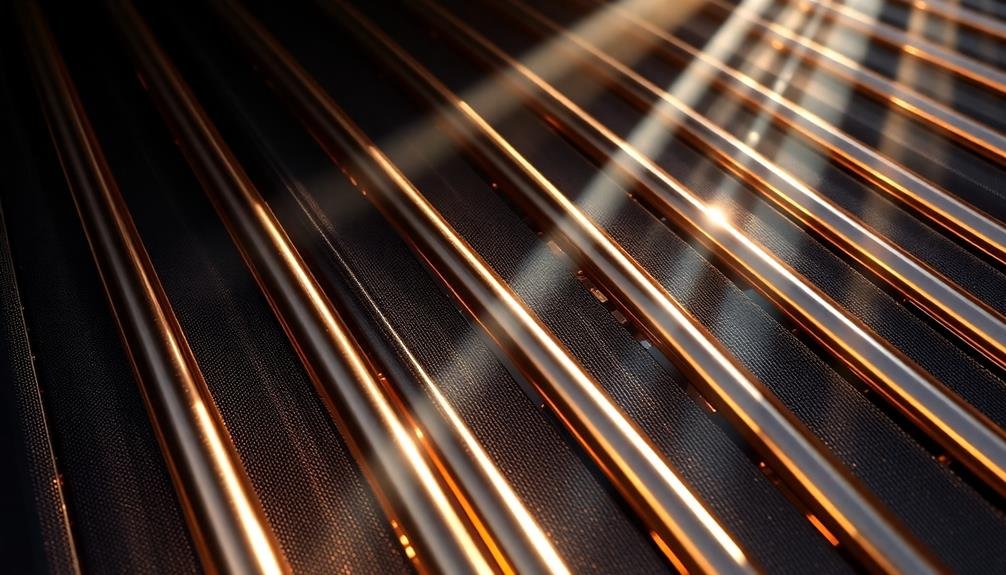
When it comes to maximizing the efficiency of solar water heaters, choosing the right heat transfer materials is essential.
You'll want to focus on materials with high thermal conductivity to guarantee rapid heat transfer from the solar collector to the water. Copper is often the top choice due to its excellent heat conduction properties and corrosion resistance. It's widely used in both flat-plate and evacuated tube collectors.
For the absorber plate, you should consider selective coating materials like black chrome or titanium oxide. These coatings enhance solar absorption while minimizing heat loss through radiation.
In the storage tank, you'll benefit from using materials with low thermal conductivity to prevent heat loss. Stainless steel is a popular option due to its durability and resistance to corrosion.
Don't overlook the importance of heat transfer fluids in indirect systems. Propylene glycol is commonly used for its antifreeze properties and heat transfer efficiency.
For direct systems, water remains the most cost-effective option. By carefully selecting these materials, you'll considerably improve your solar water heater's performance and longevity.
Optimal Tank Size Selection
When selecting a solar water heater tank, you'll need to balance volume with your household's hot water needs.
You should consider a tank size that can store enough hot water for daily use without excess capacity, which can lead to wasted energy.
Additionally, you'll want to factor in the tank's insulation quality, as better-insulated tanks retain heat more effectively, reducing the need for larger volumes.
Volume vs. Household Needs
Selecting the right tank size for your solar water heater is vital for ideal performance and efficiency. You'll need to take into account your household's daily hot water consumption to determine the appropriate volume. A tank that's too small won't meet your needs, while an oversized tank wastes energy and increases heat loss.
To estimate your household's requirements, calculate the average daily hot water usage. Reflect on the number of occupants, their bathing habits, and appliances that use hot water. As a general rule, allocate 15-20 gallons per person per day. For a family of four, a 60-80 gallon tank is typically sufficient.
However, don't just rely on this guideline. Factor in peak usage times, such as mornings when multiple showers might occur simultaneously. If you have high-demand appliances like a jacuzzi or washing machine, you'll need to account for their consumption as well.
It's often better to slightly oversize your tank to make sure you don't run out of hot water during peak times. Remember, a well-insulated tank can minimize heat loss, making a slightly larger tank more feasible without significant energy waste.
Insulation and Heat Retention
Insulation plays an essential role in maximizing the efficiency of your solar water heater. Proper insulation helps retain heat and reduces energy losses, guaranteeing that the water you've heated stays hot for longer periods.
When selecting insulation for your solar water heater, consider materials with high R-values, which measure thermal resistance. The higher the R-value, the better the insulation's performance.
Don't overlook these key areas when insulating your solar water heater:
- Tank: Wrap the storage tank with a specially designed insulation jacket
- Pipes: Insulate all hot water pipes, especially those exposed to cooler temperatures
- Valves and fittings: Use insulation tape or foam to cover these heat loss points
- Collector box: Guarantee the solar collector is well-insulated to minimize heat escape
- Expansion tank: If present, insulate this component to maintain overall system efficiency
You'll want to pay special attention to areas where heat can easily escape, such as joints and connections. Use heat-resistant tape to seal any gaps in the insulation.
Circulation System Design
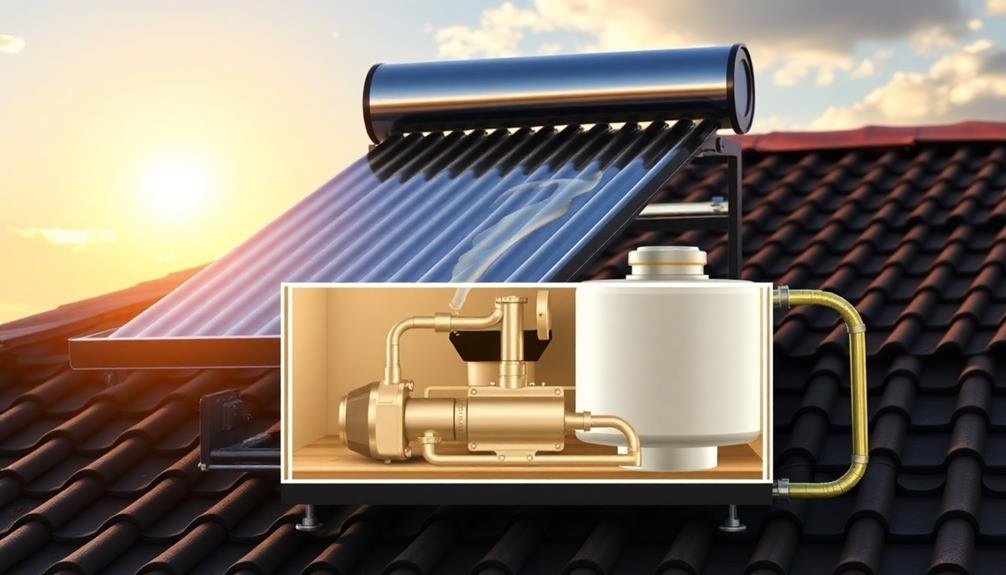
The circulation system is the lifeblood of an efficient solar water heater. It's responsible for moving water between the collector and storage tank, ensuring ideal heat transfer. When designing your circulation system, you'll need to choose between active and passive systems. Active systems use pumps to circulate water, while passive systems rely on natural convection.
For active systems, you'll want to select an appropriately sized pump that can handle the flow rate and head pressure of your system. Consider using variable speed pumps to enhance energy efficiency. Pipe sizing is vital; undersized pipes can lead to increased pumping costs and reduced efficiency.
Here's a comparison of active and passive circulation systems:
| Feature | Active System | Passive System |
|---|---|---|
| Efficiency | Higher | Lower |
| Installation Cost | Higher | Lower |
| Maintenance | More complex | Simpler |
When designing your circulation system, don't forget about freeze protection in colder climates. You can use antifreeze solutions or drain-back systems to prevent damage from freezing temperatures. Additionally, incorporate check valves and air vents to prevent reverse flow and air locks, ensuring smooth operation of your solar water heater.
Freeze Protection Strategies
Freeze protection is a key factor for solar water heaters, especially in regions that experience cold winters.
You'll need to implement effective strategies to prevent damage to your system's components and guarantee its longevity. One common approach is using antifreeze solutions in closed-loop systems, which circulate through the collectors without mixing with the potable water supply.
Another method is the drain-back system, where water in the collectors automatically drains into a storage tank when the pump stops. This prevents water from freezing in the exposed pipes and collectors.
For areas with milder winters, you might opt for freeze-tolerant collectors that can withstand occasional freezing without damage.
Here are five additional freeze protection strategies to keep in mind:
- Installing heat tape or insulation on exposed pipes
- Using vacuum tube collectors, which are naturally resistant to freezing
- Implementing active freeze protection systems with temperature sensors and controllers
- Employing recirculation techniques to keep water moving during cold nights
- Incorporating freeze valves that open to release pressure when temperatures approach freezing
Glazing Options for Collectors
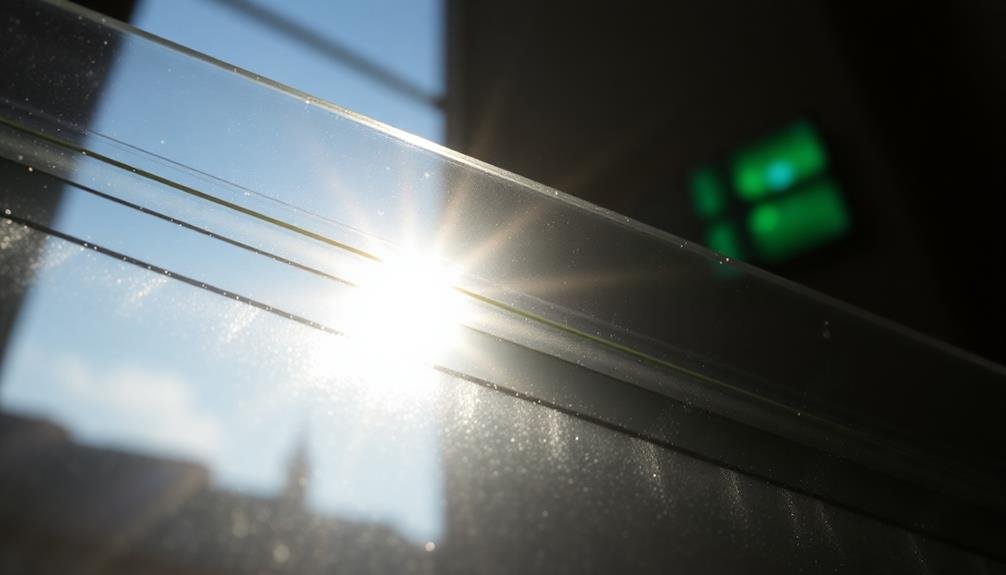
Glazing plays an essential role in the efficiency of solar water heater collectors. It's the transparent cover that allows sunlight to pass through while trapping heat inside. You'll find several options available, each with its own set of advantages.
Low-iron glass is a popular choice due to its high solar transmittance and durability. It's more expensive than standard glass but offers better performance.
Tempered glass is another option, providing increased strength and safety, especially in areas prone to hail or extreme weather.
Polycarbonate sheets are lightweight and impact-resistant, making them suitable for DIY installations. However, they may yellow over time, reducing efficiency.
For evacuated tube collectors, borosilicate glass is often used due to its low thermal expansion coefficient and resistance to thermal shock.
Anti-reflective coatings can be applied to any glazing material to improve light transmission. Some manufacturers also offer self-cleaning coatings that help maintain efficiency by reducing dirt accumulation.
When selecting glazing, consider your climate, budget, and long-term performance goals. The right choice can greatly boost your solar water heater's efficiency and lifespan.
Backup Heating Integration
When optimizing your solar water heater, it's essential to take into account backup heating options for cloudy days or high-demand periods.
You'll find several integration choices, including electric backup systems, gas-fired secondary heating, and hybrid heat pump solutions.
Each option offers unique benefits, allowing you to tailor your system to your specific needs and local energy availability.
Electric Backup Systems
For times when solar energy isn't sufficient, electric backup systems come into play. These systems guarantee a consistent hot water supply regardless of weather conditions or time of day. Electric backup elements are typically integrated directly into the solar storage tank, activating automatically when water temperature drops below a preset level.
To enhance your electric backup system:
- Choose an appropriately sized heating element based on your household's needs
- Install a timer to restrict backup heating to off-peak hours, saving on electricity costs
- Use a smart controller that learns your usage patterns and adjusts heating accordingly
- Confirm proper insulation of your storage tank to minimize heat loss and reduce backup reliance
- Consider a heat pump water heater as a more efficient electric backup option
When selecting an electric backup system, prioritize energy efficiency to maintain the eco-friendly benefits of your solar water heater. Look for models with high Energy Factor (EF) ratings and consider those with demand-response capabilities for better grid integration.
Regular maintenance of your backup system, including checking for mineral buildup on heating elements, will guarantee peak performance and longevity. By carefully integrating and managing your electric backup system, you'll maximize the benefits of your solar water heater while ensuring reliable hot water access.
Gas-Fired Secondary Heating
Why rely solely on electricity when gas can provide an efficient backup for your solar water heater? Gas-fired secondary heating offers a reliable and cost-effective solution for guaranteeing hot water availability during cloudy days or periods of high demand.
By integrating a gas-fired backup system, you'll benefit from faster heating times and lower operational costs compared to electric alternatives.
When selecting a gas-fired backup system, consider tankless water heaters for their compact size and energy efficiency. These units only heat water on demand, reducing standby energy losses.
Alternatively, you can opt for a gas storage tank that works in conjunction with your solar system. To maximize effectiveness, choose a system with electronic ignition rather than a pilot light.
Ascertain proper sizing of your gas-fired backup to complement your solar water heater's capacity. Install a controller that prioritizes solar heating and only activates the gas backup when necessary.
This approach minimizes gas consumption while maintaining consistent hot water supply. Don't forget to schedule regular maintenance for your gas-fired system to guarantee peak performance and safety.
Hybrid Heat Pump Integration
Another innovative approach to backup heating for solar water heaters is the integration of hybrid heat pumps. These systems combine the efficiency of heat pumps with the reliability of traditional electric resistance heating. When solar energy isn't sufficient, the heat pump takes over, extracting heat from the surrounding air to warm your water. If temperatures drop too low for the heat pump to operate effectively, the electric resistance element kicks in as a final backup.
Hybrid heat pump integration offers several advantages:
- Higher efficiency compared to standard electric backup systems
- Lower operating costs, especially in moderate climates
- Reduced carbon footprint due to improved energy utilization
- Versatility in handling varying weather conditions
- Potential for year-round energy savings
To maximize the benefits of a hybrid heat pump system, you'll need to carefully size the components and optimize the control strategy.
Consider factors such as your local climate, hot water usage patterns, and available space for installation. You may also want to explore smart controls that can learn your household's habits and adjust the system accordingly.
Smart Controls and Monitoring
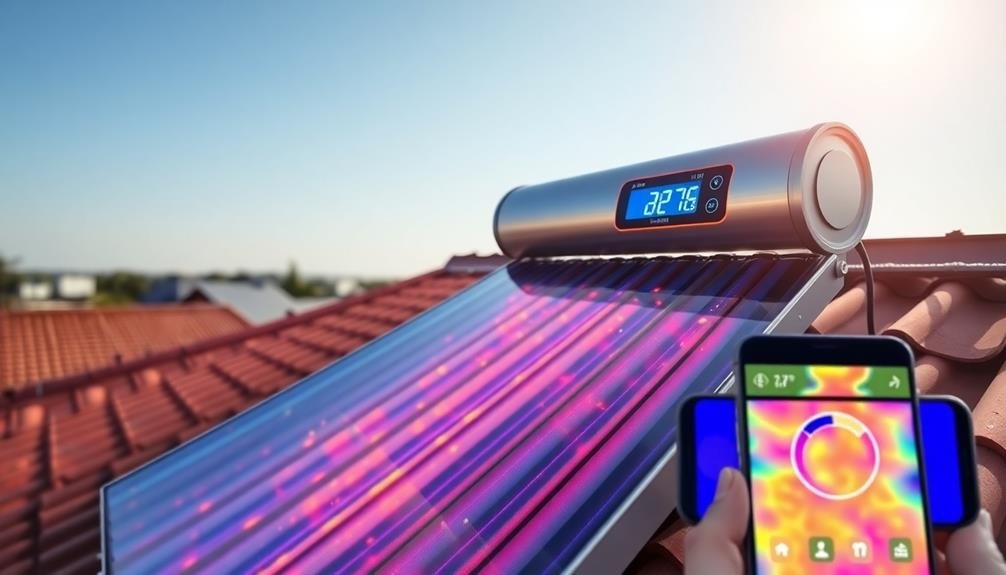
Many solar water heater systems now incorporate smart controls and monitoring technologies, revolutionizing their efficiency and user experience.
These advanced systems allow you to monitor and control your solar water heater remotely through smartphone apps or web interfaces. You'll have real-time access to data on water temperature, energy production, and system performance.
Smart controls optimize your solar water heater's operation by adjusting settings based on weather forecasts, energy prices, and your household's hot water usage patterns. They can automatically switch between solar and backup heating modes to guarantee you always have hot water while maximizing solar energy use.
You'll benefit from features like leak detection, which alerts you to potential issues before they become major problems.
Some systems even integrate with home automation platforms, allowing seamless coordination with other smart devices. Energy consumption tracking helps you understand your usage patterns and identify opportunities for further savings.
Scaling for Multi-Unit Applications
When scaling solar water heaters for multi-unit applications, you'll need to take into account centralized versus distributed systems.
You'll want to design efficient plumbing layouts that minimize heat loss and maximize distribution effectiveness.
To guarantee consistent hot water supply, you should implement load balancing techniques that account for varying demand across different units.
Centralized vs. Distributed Systems
Scalability presents an essential consideration when implementing solar water heating systems for multi-unit buildings. When designing these systems, you'll need to choose between centralized and distributed configurations. Centralized systems use a single, large solar collector array and storage tank to serve multiple units, while distributed systems employ individual collectors and tanks for each unit.
Centralized systems offer several advantages:
- Lower installation and maintenance costs
- Easier monitoring and control
- More efficient use of available roof space
- Better performance in buildings with varying hot water demands
- Simplified integration with existing building systems
However, distributed systems have their own benefits. They provide greater flexibility in system design and allow for individual metering of hot water usage. You'll also find that distributed systems are less prone to complete failure, as a malfunction in one unit won't affect the entire building.
When deciding between centralized and distributed systems, consider factors such as building layout, roof space availability, and hot water usage patterns.
You may also want to evaluate the potential for future expansion and the ease of integrating with existing plumbing infrastructure. Ultimately, the choice depends on your specific building requirements and long-term goals for energy efficiency and cost-effectiveness.
Efficient Plumbing Layouts
After choosing between centralized and distributed systems, you'll need to focus on efficient plumbing layouts for your multi-unit solar water heating setup. Proper layout design can greatly improve system performance and reduce heat loss.
Start by minimizing pipe lengths between the solar collectors and storage tanks to decrease thermal losses. Use insulated pipes throughout the system, paying special attention to outdoor sections.
Implement a balanced flow distribution system to guarantee equal water flow to all units. This can be achieved through reverse-return piping or flow balancing valves.
Consider using a primary-secondary loop configuration to separate the solar collection circuit from the distribution circuit, allowing for better control and efficiency.
For larger multi-unit applications, divide the system into zones based on building layout or usage patterns. This approach allows for more precise control and can reduce pumping energy requirements.
Install temperature sensors at key points in the system to monitor performance and detect issues quickly. Don't forget to include isolation valves and bypass lines for easy maintenance and system flexibility.
Load Balancing Techniques
To effectively scale solar water heating systems for multi-unit applications, you'll need to implement robust load balancing techniques. These strategies guarantee that hot water is distributed evenly across all units, maximizing efficiency and user satisfaction.
Start by calculating the peak demand for each unit and the system as a whole. This data will help you design a system that can handle varying loads throughout the day.
Contemplate implementing a primary-secondary piping configuration, which allows for better flow control and temperature regulation. You'll also want to install properly sized storage tanks to buffer demand fluctuations. Smart controllers can help optimize the system by prioritizing units based on usage patterns and time of day.
Here are key load balancing techniques to ponder:
- Use variable speed pumps for demand-based circulation
- Implement temperature sensors at multiple points in the system
- Install thermostatic mixing valves for precise temperature control
- Utilize zone valves to direct flow to high-demand areas
- Incorporate a building management system for real-time monitoring and adjustment
Maintenance-Friendly Design Features
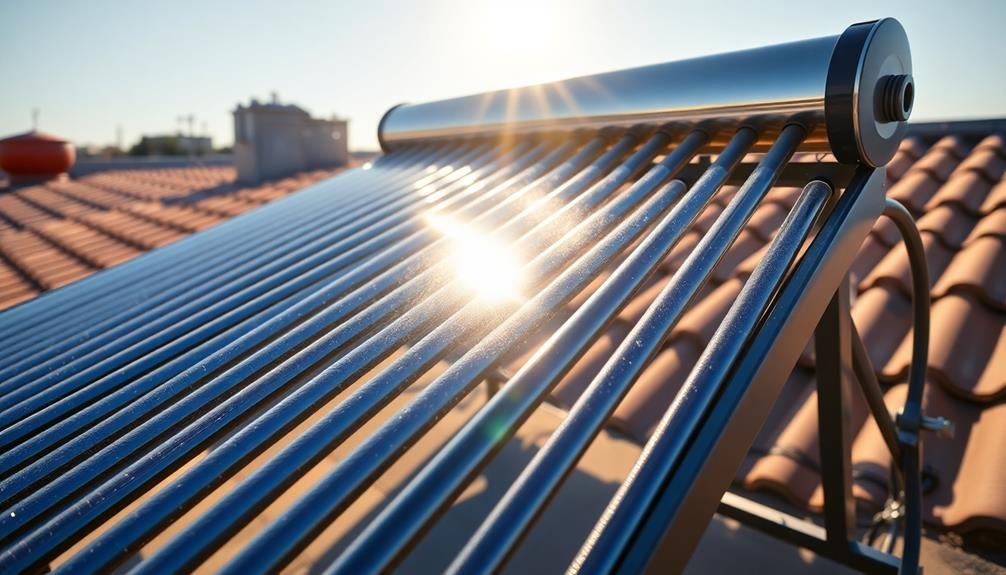
Several key design features can make solar water heaters more maintenance-friendly, ensuring their longevity and efficiency.
First, consider incorporating easily accessible panels and components. You'll want to design the system with removable covers or access points that allow for quick inspections and repairs without dismantling the entire unit.
Opt for high-quality, corrosion-resistant materials in the construction of your solar water heater. This includes using stainless steel or copper for pipes and fittings, which will reduce the need for frequent replacements.
Install a drain valve at the lowest point of the system to facilitate easy flushing and cleaning of the tank and pipes.
Implement a modular design approach, where individual components can be replaced without affecting the entire system. This will save time and money during maintenance or upgrades.
Include clear labeling and color-coding of parts and connections to simplify troubleshooting and repairs.
Don't forget to incorporate a user-friendly control panel with diagnostic features that can alert you to potential issues before they become major problems.
Frequently Asked Questions
How Long Does It Take to Recover the Initial Investment in a Solar Water Heater?
You'll typically recover your initial investment in a solar water heater within 5-10 years. However, this can vary based on factors like your location, energy costs, usage patterns, and available incentives. It's worth calculating for your situation.
Can Solar Water Heaters Work Effectively in Cloudy or Rainy Climates?
Yes, solar water heaters can work in cloudy or rainy climates. You'll still get some energy from diffuse sunlight, but they'll be less efficient. You might need a larger system or backup heating to compensate for reduced performance.
What Is the Average Lifespan of a Solar Water Heating System?
You can expect your solar water heating system to last 15-20 years on average. With proper maintenance, it's possible to extend its lifespan to 30 years or more. Regular upkeep will help you maximize your system's longevity.
Are There Government Incentives or Rebates Available for Installing Solar Water Heaters?
Yes, you'll find various government incentives and rebates for solar water heaters. Check with your local and state authorities, as well as federal programs. They often offer tax credits, grants, or cashback schemes to encourage renewable energy adoption.
How Do Solar Water Heaters Compare to Heat Pump Water Heaters in Efficiency?
You'll find that solar water heaters and heat pump water heaters are both efficient options. Solar heaters excel in sunny climates, while heat pumps work well year-round. Your choice depends on your location and energy needs.
In Summary
You've now got a solid foundation for optimizing solar water heaters. By implementing these design strategies, you'll maximize efficiency and performance. Remember, it's not just about individual components; it's how they work together. Keep experimenting and fine-tuning your designs. As technology advances, stay informed about new materials and control systems. With careful planning and attention to detail, you'll create solar water heaters that outperform expectations and provide sustainable hot water for years to come.
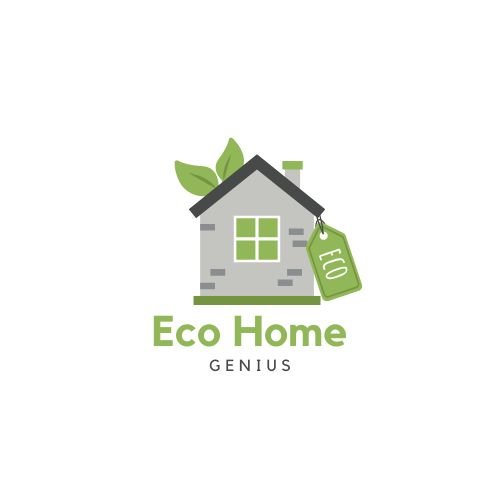
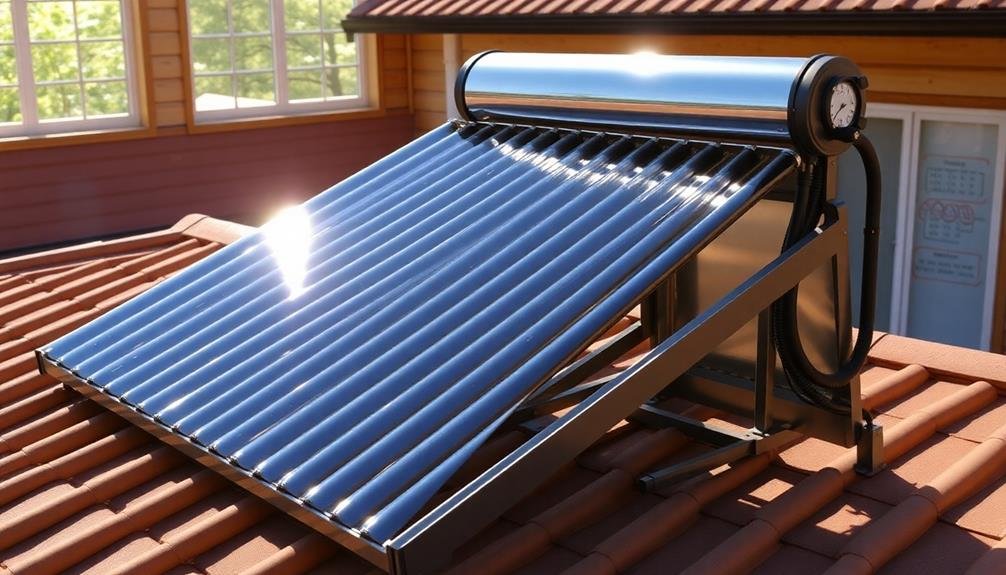
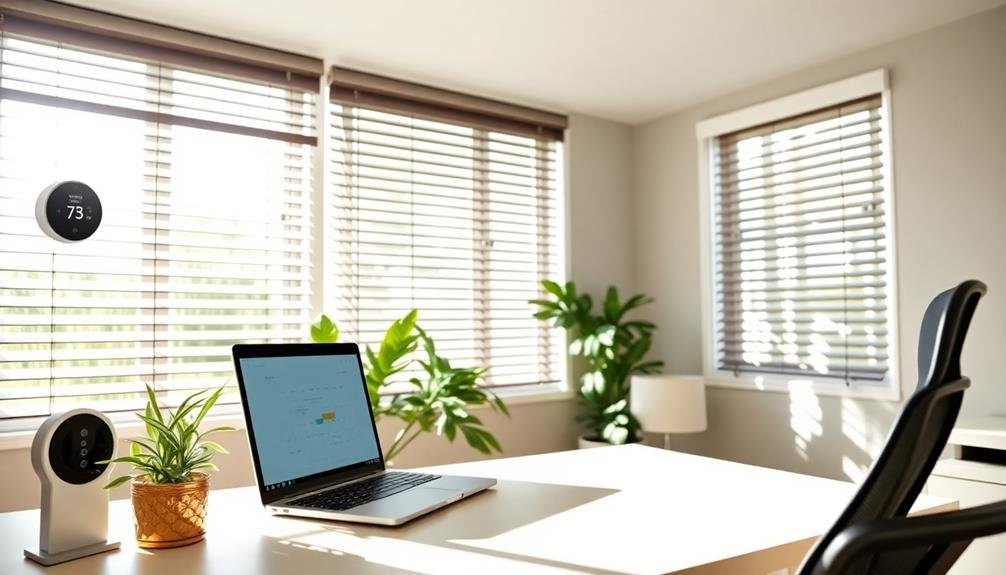
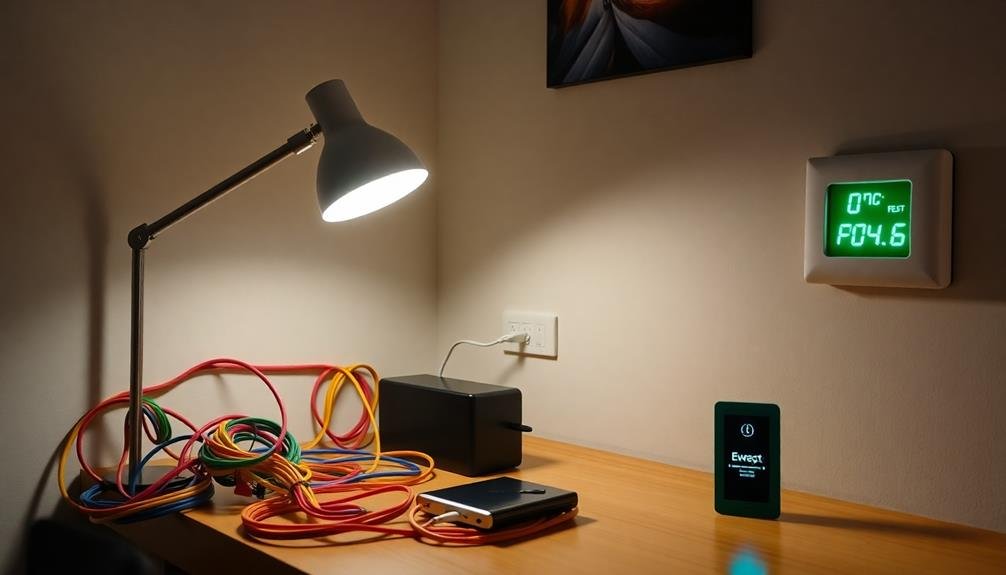
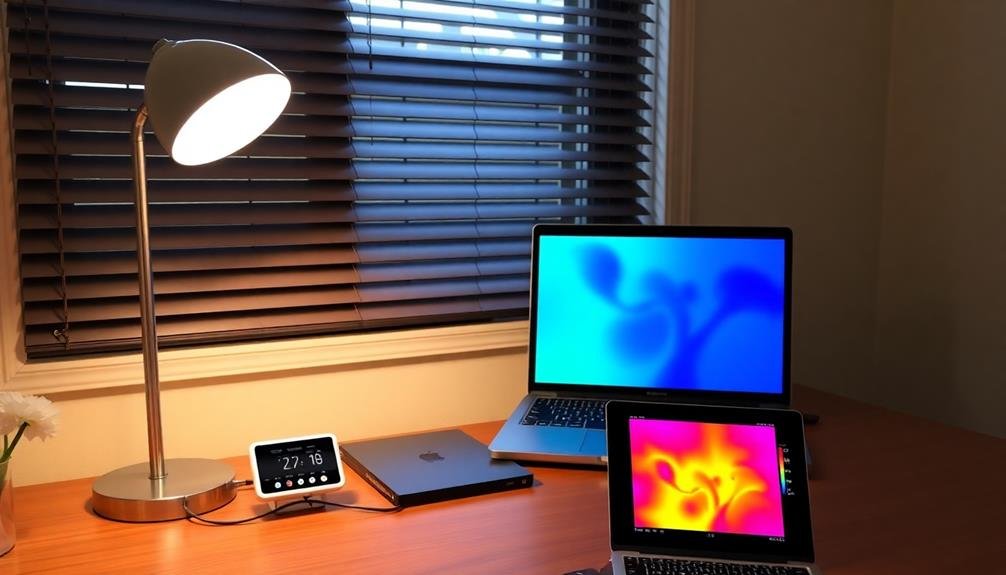
Leave a Reply